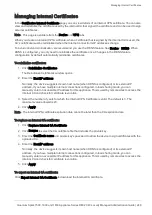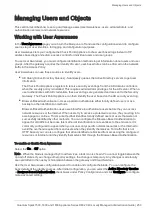
Configuring Advanced Site to Site Settings
Quantum Spark 1500, 1600 and 1800 Appliance Series R80.20.40 Locally Managed Administration Guide | 241
Configuring Advanced Site to Site Settings
In the
VPN
>
Site to Site Advanced
page you can configure global advanced options that define how the
appliance connects to remote sites.
The configuration options on this page answer these configuration questions:
n
When to open a connection with a remote site - See "Configuring a Local Encryption Domain" below.
In addition, the remote site's encryption domain is configured per site. See the
VPN
>
Site to Site
VPN Sites
page.
n
How the appliance connects to remote sites - See "Configuring the Appliance's Outgoing Interfaces
for VPN usage below.
Configuring a Local Encryption Domain
In domain based VPN, traffic is encrypted when it originates in one encryption domain and is transmitted to
a different domain.
The local encryption domain defines:
n
The internal networks that encrypted traffic from remote sites and networks can get access.
n
That traffic from the encryption domain to remote sites is encrypted.
By default, the local encryption domain is determined automatically by the appliance. Networks behind LAN
interfaces and trusted wireless networks are part of the local encryption domain. Optionally, you can
manually create a local encryption domain if necessary.
To configure a local encryption domain manually:
1. Click the
automatically according to topology
link.
2. Select
Define local network topology manually
.
3. Click
Select
to show the full list of available networks and select the applicable checkboxes.
4. Click
New
if the existing list does not contain the necessary networks required.
For information on how to create a new network object, see the
Users & Objects
>
Network Objects
page.
5. Click
Apply
.
The Site to Site Local Encryption Domain window opens and shows the services you selected.
















































